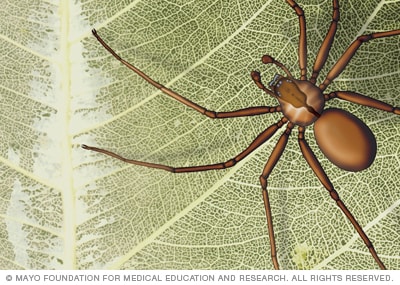Overview
Most spider bites cause only minor injury. Bites from a few spider species can be dangerous.
When to seek emergency help
Seek medical care right away if:
- You were bitten by a dangerous spider, such as a black widow or a brown recluse.
- You're unsure if the bite was from a dangerous spider.
- You have severe pain, stomach cramping or a growing wound at the bite site.
- You're having problems breathing or swallowing.
- The area of inflamed skin is spreading or has streaks.
Treatment
To take care of a spider bite:
- Clean the wound with mild soap and water. Then apply an antibiotic ointment three times a day to help prevent infection.
- Apply a cool cloth over the bite for 15 minutes each hour. Use a clean cloth dampened with water or filled with ice. This helps reduce pain and swelling.
- If possible, raise the affected area.
- Take a nonprescription pain reliever as needed.
- If the wound is itchy, an antihistamine might help. Examples are diphenhydramine or cetirizine. Or try calamine lotion or a steroid cream.
For pain and muscle spasms, your healthcare professional might prescribe pain medicine, muscle relaxants or both. You might also need a tetanus shot.
Black widow spiders
Black widow spider
Black widow spider

Black widow spider
The black widow spider is known for the red hourglass marking on its belly.
You can usually identify a black widow spider by the red hourglass marking on its belly. In the United States, this spider is more common in the South. It's also found in Europe.
Symptoms of a black widow spider bite can include:
- Inflamed skin, pain and swelling.
- Severe stomach pain or cramping.
- Nausea, vomiting, shaking or sweating.
Brown recluse spider
Brown recluse spider
Brown recluse spider

Brown recluse spider
The brown recluse spider is known for the violin-shaped marking on its top.
The brown recluse spider has a violin-shaped marking on its back, but this mark can be hard to see. This spider is commonly found in the southern half of the United States and in South America, where it is known as the brown spider.
Symptoms of a brown recluse spider bite can include:
- At first, a mild pain.
- Fever, chills and body aches.
- A sore with a blue or purple center and a ring around it.
April 30, 2024
- Dinulos JGH. Infestations and bites. In: Habif's Clinical Dermatology. 7th ed. Elsevier; 2021. https://www.clinicalkey.com. Accessed March 2, 2021.
- Thompson, DA. Spider bite. In: Adult Telephone Protocols: Office Version. 4th ed. American Academy of Pediatrics; 2019.
- Auerbach PS, et al., eds. Arthropod and mosquito bites and stings. In: Field Guide to Wilderness Medicine. 5th ed. Elsevier; 2019. https://www.clinicalkey.com. Accessed March 3, 2021.
- Venomous spiders. National Institute for Occupational Safety and Health. https://www.cdc.gov/niosh/topics/spiders. Accessed March 3, 2021.
- Brown recluse spider. Occupational Safety and Health Administration. https://www.osha.gov/OshDoc/data_Hurricane_Facts/brown_recluse_spider.html. Accessed March 3, 2021.
- Diaz JH, et al. Common spider bites. American Family Physician. https://www.aafp.org/afp/2007/0315/p869.html. Accessed March 15, 2016.
- Herness J, et al. Arthropod bites and stings. American Family Physician. https://www.aafp.org/pubs/afp/issues/2022/0800/arthropod-bites-stings.html. Accessed Feb. 6, 2023.